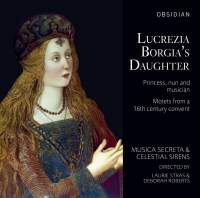Texte paru dans: / Appeared in: |
|
|
Outil de traduction ~ (Très approximatif) |
|
|
Reviewer: Barry
Brenesal “An obscure book of motets … although entirely anonymous, contains clues to its origins that lead us to the door of Leonora d’Este’s home, the convent of Corpus Domini in Ferrara, perhaps even suggesting that she was its unidentified composer.” It’s on the strength of no more than this unsupported suggestion in the liner notes that the album’s title is given as Lucrezia Borgia’s Daughter. That’s not much evidence of composition; in fact, none. The comment is all the more suspect in that Leonora is nowhere actually stated on the jewel box or in the liner notes as the composer, and because the picture on the album’s cover is that of her mother. In other words, this link to Leonora d’Este gives the impression of being all about marketing. And while it’s understandable that the album’s creators would wish to gain a wider audience for their material than they might otherwise expect from the number of listeners who enjoy restrained, mid-16th century convent motets, I have to wonder whether the sacrifice of reality in search of popular hooks is ever rewarded by increased classical CD sales. In any case: Ferrara was the domain for hundreds of years of the d’Este clan, who governed it with varying degrees of success until 1796, when the troops of Napoleon Bonaparte paid the last resident ruler a visit. Corpus Domini was one of the family’s major centers of worship over the centuries, heavily patronized by the d’Estes, and the burial place of many of their members. They were for the most part great appreciators of the arts as well, in particular music, and this was something that Leonora brought with her when she was installed as abbess at the Clarissan convent at the age of 18. She kept an organ, harpsichord, and clavichord in her private quarters, and was praised—not for her compositions, but for her patronage of musicians and musical theorists. (It was customary for members of arts-related professions to dedicate given works to wealthy nobles, who would in turn pay for their publications.) So we know at best that Leonora d’Este had some training in and a great appreciation for music, as well as the funds to support this enthusiasm in a princely style. The 1543 publication by Venetian printer Girolamo Scotto (himself a composer) of 43 motets from Corpus Domini, in a score entitled Musica quinque vocum motetta materna lingua voccata, was possibly either paid for by her, or by members of her family upon request. No composers are listed, and given the differing levels of musical technique and contrasting stylistic choices in the 16 motets included on this release, they may have been the work of many hands—though of course, it’s impossible to tell for certain. Perhaps Leonora wrote several, and included works by nuns she may have taught. There are many possibilities, and no answers to date. While all the music is worth hearing once, some selections call for numerous repeat performances. The short, charming Sicut lilium inter spinas, more distinctly chordal than most of the other motets here, sounds almost Flemish in the cut of its melody. By contrast, Angelus Domini descendit circles a haze of variations in augmentation and division around a small series of shifting harmonies that chase their own tail. O beate Christi confessor deploys extensive imitative passages, the occasional false relation, and a sudden, dramatic switch to chords at the pleading phrase ab omni malo (from all evil) to score its points effectively. Finally, Haec dies quam fecit Dominus, though not as long as several of the others, possesses a sophistication, technical ambition, and ingenuity that stand out—not only among the rest of the cuts on this disc, but after a fashion that would draw attention in any contemporaneous grouping of motets. Whomever its composer was, she must surely have taken pleasure in this refined gem. The singing is overall quite good, though one or more of the sopranos occasionally seem to slur. I’ll be the first to admit, though, that it’s difficult to tell this for certain. The use of a straight, vibratoless tone may have occasioned the cathedral ambiance, but whatever the reason, it is moderately difficult to follow individual musical lines. Enunciation, too, suffers greatly. I wish some effort had been made to record this music with its frequently dense contrapuntal weave in a manner that let the strands stand out better.
That said,
Laurie Stras and Deborah Roberts have unearthed some intriguing, often
complex music on this album, and—despite my concerns over the
engineering—have clearly managed to train their singers in its proper
performance. All of it is at least slightly interesting, but I’d suggest
going to it for Haec dies quam fecit Dominus. If you enjoy that, you may
stay for the rest.
| |
|
Support us financially by purchasing this disc from eiher one of these suppliers. Un achat via l'un ou l'autre des fournisseurs proposés contribue à défrayer les coûts d'exploitation de ce site. |
|
|
|
|
|
Cliquez l'un ou l'autre
bouton pour découvrir bien d'autres critiques de CD |
|




